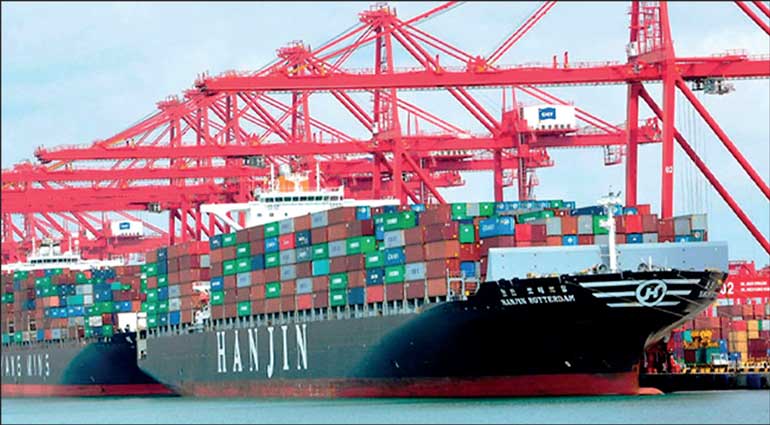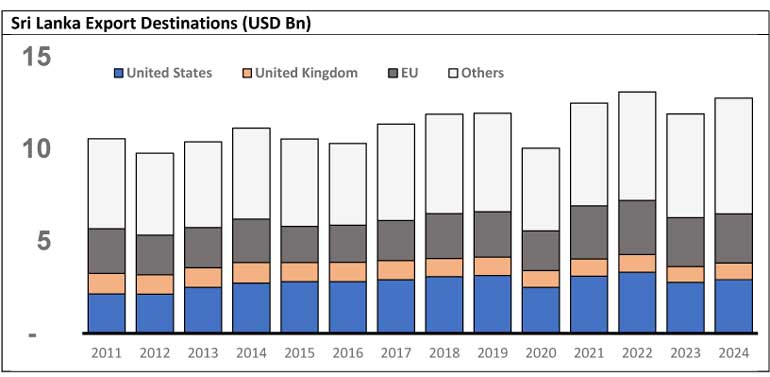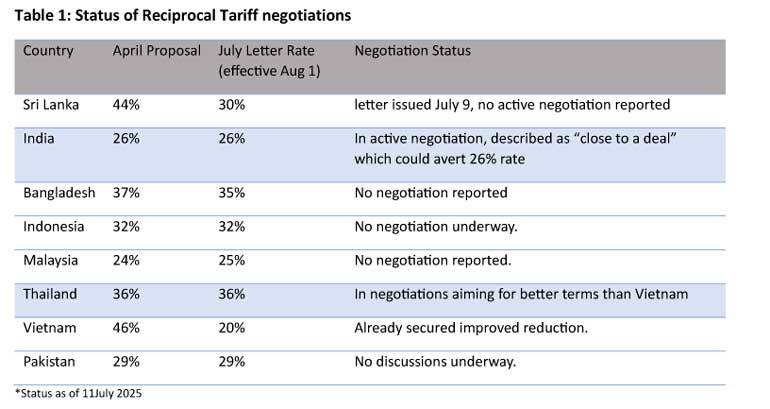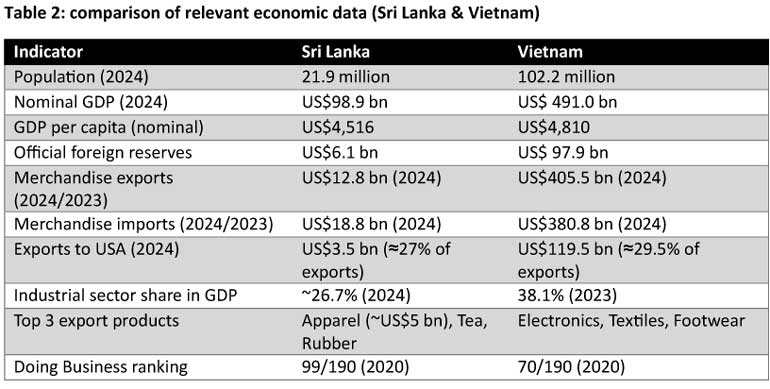Sunday Dec 14, 2025
Sunday Dec 14, 2025
Thursday, 17 July 2025 00:10 - - {{hitsCtrl.values.hits}}

The Government seems to be complacent about the reduction of the reciprocal tariff to 30% from the previous 44%
 The US is making revisions to its reciprocal tariff regime, which was initially presented in early April this year, and subsequently deferred for a three-month period to be ended on 9 July 2025. The US President has since then revised the tariffs applicable to certain countries after negotiation with the counterparts. Sri Lanka also engaged with US trade officials (USTR) expecting a revision to the tariff applicable to Sri Lanka; which was initially one of the highest rates in the world at 44%.
The US is making revisions to its reciprocal tariff regime, which was initially presented in early April this year, and subsequently deferred for a three-month period to be ended on 9 July 2025. The US President has since then revised the tariffs applicable to certain countries after negotiation with the counterparts. Sri Lanka also engaged with US trade officials (USTR) expecting a revision to the tariff applicable to Sri Lanka; which was initially one of the highest rates in the world at 44%.
The US publicly announced that the reciprocal tariff applicable to Sri Lanka will be reduced to 30% from the previous 44% tariff rate. This tariff rate, despite a notable reduction, is still amongst the highest, while competing countries such Vietnam have been able to markedly reduce the tariff rate applicable them to a competitive level of 20%. Originally, the reciprocal tariff applicable to Vietnam at 46% was even higher than Sri Lanka. Vietnam has a huge trade deficit many times higher than Sri Lanka, since bilateral trade between the US and Vietnam is very significant to the US.
Sri Lanka depends heavily on the US market for key exports, especially for apparel, which is the largest export product from Sri Lanka. A country with very limited export diversification, and an over reliance on non-tradable goods for growth over the previous 2-3 decades could be severely impacted by the proposed tariff rates.
Understanding the importance of the US market as the single largest market in the world, most countries engaged with the President and trade officials to seek a reduction of their trade deficit and tariff by agreeing on a mutually beneficial framework. Vietnam being a strategic partner of the US in the Asia Pacific region engaged extensively with the US and negotiated a significant reduction to 20%; a very competitive position. Unlike Sri Lanka, Vietnam has a huge export based industrial sector and very high contribution of exports to GDP. The country exports computers, electrical products, spare-parts and components, and machinery, equipment, tools and instruments worth nearly $ 50 billion.
Drawing lessons from Vietnam, India, Philippines, and Malaysia, there are numerous actionable steps the Government of Sri Lanka can take immediately with a view of reducing the US reciprocal tariff rate from 30% to 20% or less before the 1 August 2025, deadline.
Trade concessions and market access
Sri Lanka could offer to reduce customs duties on the top 10 US exports to Sri Lanka (e.g., aircraft parts, semiconductors, machinery, medical devices) and plan to eliminate quotas and non-tariff barriers on US dairy, poultry, corn, and soybean imports. Remove special duties or para-tariffs on US pharmaceuticals and medical equipment, and offering zero-duty access for select US ICT goods and clean energy components (e.g., solar inverters, EV batteries) would encourage more imports to Sri Lanka from the US.
In addition, Sri Lanka could sign a fast-track customs clearance MoU for US goods entering country’s ports, while updating food safety and labelling standards to match Codex/WTO norms (in line with US demands). In the agriculture sector, one of the most important areas for US firms, Sri Lanka could allow US seed and agri-input companies to engage in pilot tech trials under Department of Agriculture supervision. These actions would collectively entice US exports to Sri Lanka and further bridge the trade gap.
Investment facilitation and strategic access
The country should plan for a mutually beneficial investment and trade framework offering high end US firms to look at Sri Lanka as a strategic market. In this regard, we could offer US firms exclusive access to 1–2 renewable energy tenders (solar, wind, LNG), permit US infrastructure companies to bid on port logistics, MRO, or airport privatisation projects, and allocate a special industrial zone or customs bonded hub for US firms near the Colombo Port. Further, signing a bilateral investment protection agreement (BIPA) or updating existing treaty and fast-track approvals for US FDI projects through a US-SL desk at BOI could help both countries.
Strategic alignment and diplomatic engagement
Sri Lanka needs to progressively involve US as a significant trade partner by signing a bilateral Trade and Investment Framework Agreement (TIFA). In terms of alignment with the interest of the US, the country would need to publicly support the US Indo-Pacific economic and maritime security vision in key forums. While this is a controversial subject, Sri Lanka should draw lessons from countries like Taiwan, South Korea and lately Vietnam. Extending the current relationship with the US, Sri Lanka could offer visiting US naval vessels expanded access to the Colombo and Trincomalee ports.
Holding a joint US-Sri Lanka Economic Dialogue before 25 July as a visible signal, as well as sending a cabinet-level trade delegation to Washington D.C. would also fast track the possible softening of the reciprocal tariff. Internally, Sri Lanka should form a Presidential task force with experienced public and private sector personal to manage and finalise the tariff negotiation process.
Bilateral procurement and strategic purchases
Since Sri Lanka is still under the IMF framework, driving any capital expenditure for high value equipment such as military aircraft is not economically possible. Nevertheless, the country can agree on a framework to place a limited order of US aircraft spare parts or utility helicopters (i.e. for disaster response) or signing a MoU to collaborate on pharma security and local vaccine production with US firms. Sri Lanka can commit to purchasing a quota of US agricultural commodities via government-to-government channels.
Public relations, legal and policy positioning
The Government should deviate from an ingrained traditional mindset that the Government mechanism is capable of everything. Similar to how Lazards handled Sri Lanka’s debt restructuring process by bringing in external expertise required for that process, Sri Lanka should deploy a professional US lobbying firm (as India and Vietnam did) to represent country’s interests in Congress and USTR. This is an area of expertise the traditional government mechanism is not currently capable of.
Sri Lanka should also run a joint press release and white paper showing progress on tariff parity with ASEAN and submit a formal WTO notification of planned tariff and trade rule alignment with the US. The country should publish a “Sri Lanka-US Tariff Normalisation Roadmap” with dated targets and legislative commitments, demonstrating strong willingness to the counterparty.
Domestic coordination and trade readiness
The Government should conduct internal consultations with the local industry to prepare for US import competition and obtain views of exporters to better understand the actions to be taken to protect US exports. The Government should prepare to amend regulations to allow faster registration of US made pharmaceuticals and agricultural products, cap inspection fees and minimise border friction for containerised US cargo, and create a digital dashboard to track trade progress and fulfil commitments transparently to both governments.
Urgency and deadline
The Government seems to be complacent about the reduction of the reciprocal tariff to 30% from the previous 44%. The rate should not be viewed in isolation. Competing countries have received better deals, and a relatively higher tariff could deteriorate the countries competitiveness and industrial exports over the next couple of years. This will not be good for the Government’s future if the industries are forced to close down due to an uncompetitive tariff.
These actions must begin immediately and be substantially visible to the USTR and the White House by 25 July, to create room for tariff downgrading before the 1 August cutoff. Failure to act decisively will result in Sri Lanka being grouped with high-tariff targets, limiting its export competitiveness and leverage in future bilateral deals.



(The writer is a CFA charterholder; capital market specialist and certified FRM. The views and opinions expressed in this article are those of the writer and do not necessarily reflect the official policy or position of any institution.)